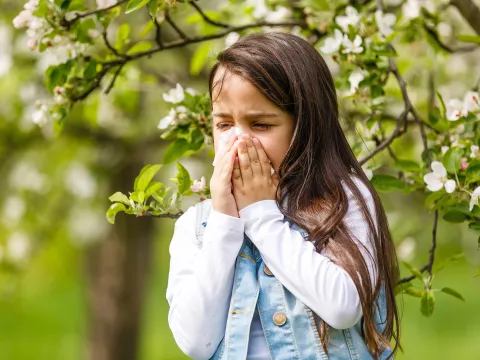- AdventHealth

Choose the health content that’s right for you, and get it delivered right in your inbox.
For a growing number of families, allergies in children are an unfortunate reality — and one that’s often misunderstood by those who don’t live with a child who has allergies. We’re here to explain how allergies in kids occur, who typically gets them, the most common allergies in kids and treatment options for relief.
How Do Allergies in Kids Occur?
Allergies occur from an abnormal immune response to certain environmental agents or proteins in specific foods. The symptoms are the body’s way of reacting against what it perceives as dangerous. Allergic reactions can be mild, moderate or severe. There is currently no cure for allergies, but there are therapies and lifestyle choices that can help.
Allergy Symptoms in Kids
A child can be allergic to anything, from foods to pets to something they touch outdoors. It’s important to treat their symptoms immediately before they get worse. Seek medical attention right away for emergency symptoms like:
- Anaphylaxis (look for constriction/tightening of the airways, lump in the throat, dizziness, confusion, loss of consciousness)
- Hives or itchy skin
- Dizziness, lightheadedness or fainting
- Itching or tingling in or around the mouth
- Nasal congestion
- Stomach pain, diarrhea or nausea
- Swollen lips, face, tongue or throat
- Vomiting (likely due to throat swelling rather than gastrointestinal issues)
- Wheezing
Using an EpiPen
Anaphylaxis can be life-threatening. Parents of children with severe allergies typically carry an EpiPen (contains epinephrine), which can be used in emergencies to counteract severe allergic reactions or anaphylaxis. If you do use the EpiPen, you still need to get your child to the hospital. Antihistamines such as Benadryl can be used for mild or moderate reactions. The key is to make sure the child’s airways stay open with no difficulty breathing.
Which Children Get Allergies?
Anyone can get allergies, but they tend to run in families. If you or your spouse have them, it’s more likely you might have a child with allergies. If neither parent has allergies, your child may still have them.
Your environment also influences whether or not your child will develop allergies. Exposure to an allergen will tend to cause an allergic reaction. The more intense the exposure, the more often your child is in contact with the allergen, and the earlier it happens in their life, the more likely they’ll develop an allergy.
Other factors that influence who gets allergies include whether or not a parent smokes, pollution, hormones and infections.
9 Most Common Allergies in Kids
Many of the most common allergies in kids are food allergies, such as to peanuts, dairy, soy and wheat. Others include environmental and pet allergies.
1. Dairy and Egg Allergies
Avoid foods that contain milk, milk powder, butter and cream. Cow’s milk is most commonly the source of milk allergies. Some kids with cow’s milk allergies may be able to have goat’s or sheep’s milk, but many cannot have these, either.
Look for alternative, plant-based milks, such as rice or oat, that do not conflict with other food allergies you may have, like nuts or soy. If you do not have a nut or soy allergy, almond, cashew and soy milks are popular alternatives.
Most kids with an egg allergy are actually allergic to the egg whites rather than the yolks. As common as egg allergies are in children, they’re also among the most common food allergies that are eventually outgrown.
2. Fish and Shellfish Allergies
Fish allergies are common, but they may be confused with an adverse reaction to contaminated fish. It’s common for fish allergies to develop later in life rather than in childhood. For kids with shellfish allergies, avoid shrimp, prawns, crayfish, lobster, squid and scallops.
3. Peanuts Allergies
Peanut allergies can be fatal. Some kids can’t even touch or inhale residue from peanuts. When eating out or in public, always let those who will be handling your food know of your allergy and that care must be taken to avoid cross-contamination with other foods. It's uncommon to outgrow a peanut allergy, and they often grow worse with every exposure.
4. Pet Allergies
Pet allergies are allergic responses to the proteins found in a cat or dog's skin cells, saliva or urine, but it's most often triggered by exposure to pet dander. When the child is around a pet, the symptoms are similar to what they would experience with seasonal allergies.
5. Tree Nut Allergies
Examples of common tree nuts are almonds, walnuts, pine nuts, macadamia nuts, cashews and coconuts. Avoid any product that contains specific allergens, such as nut butters, nut milks and nut oils.
6. Seasonal Allergies
Seasonal allergies affect millions of kids every year. If you notice itchy, watery eyes, a stuffy or runny nose, cough, wheeze, sore throat and congestion that coincide with a change in seasons, it may be allergies. Colds or cold symptoms that last many weeks may be an allergy instead of an infection, so be sure to talk to your child's pediatrician.
7. Soy Allergies
Soy is found in many foods, so always be mindful to read the labels. Avoid soybeans (edamame), soy milk, soy sauce and tofu.
8. Wheat Allergies
A true wheat allergy is different from celiac disease or gluten sensitivity, which both disrupt the digestive system but are not life-threatening. A wheat allergy causes an abnormal immune response to one of the many proteins found in wheat.
9. Skin Allergies
The Centers for Disease Control and Prevention (CDC) reports that cases of skin allergies have increased by more than 5% between 1997 and 2011 in people under 18 years old. Luckily, the prevalence tends to decrease with age. They’re typically easy to identify due to the visible reaction that occurs.
Treatment Options for Kids With Allergies
Your child’s pediatrician is the best resource to know how to treat your child’s specific allergy. In general, these are some of the best, most effective treatment options for kids’ allergies:
- Allergy shots
- Antihistamines like Benadryl
- Decongestants
- Limiting exposure to allergens
We’re also here for you and your family with our world-class children’s care, allergy care and network of allergy specialists. We can provide the relief you need to live healthier and safer. We even have pediatric allergists to help with everything from common allergies to asthma, and we invite you to learn more here.



